To master epic aerial pans, you'll need high-quality gear like stabilized drones and cameras with ND filters. Plan your shots carefully, considering composition, lighting, and movement direction. Practice smooth drone control, using yaw functions and adjusting sensitivity. Perfect your timing and speed, varying it for dramatic effect. Employ advanced techniques like intelligent flight modes and gimbal adjustments. In post-production, enhance your footage with stabilization and color grading. Overcome challenges like wind and battery life by choosing ideal conditions and planning efficiently. With these pro secrets, you'll be on your way to creating cinematic aerial masterpieces that captivate viewers.
Key Takeaways
- Use high-quality drones with advanced stabilization features for smooth, steady aerial pans.
- Master drone controls through practice, focusing on yaw function and control sensitivity adjustments.
- Plan shot composition carefully, considering visual elements, movement direction, and lighting conditions.
- Experiment with varying drone speeds and altitudes to create dynamic and engaging aerial pans.
- Enhance footage in post-production with stabilization techniques and color grading for professional results.
Essential Gear for Aerial Pans
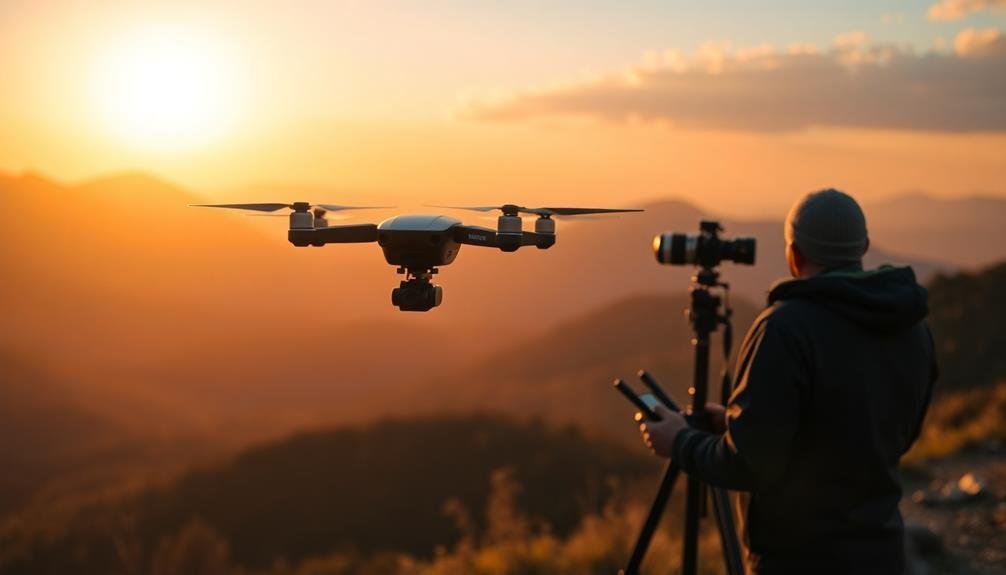
To capture stunning aerial pans, you'll need the right equipment. Start with a high-quality drone capable of smooth, stable flight. The DJI Mavic 3 or Autel EVO II Pro are excellent choices for professional-grade aerial cinematography. Confirm your drone has a gimbal-stabilized camera with at least 4K resolution and adjustable frame rates.
Invest in a set of neutral density (ND) filters to control exposure and achieve cinematic motion blur. A polarizing filter can help reduce glare and enhance colors. Don't forget extra batteries and memory cards to maximize your shooting time.
For precise control, use a dedicated remote controller with a built-in or attachable screen. Some advanced controllers offer dual-operator functionality, allowing one person to fly while another controls the camera.
To plan and execute complex shots, consider using flight planning software like Litchi or DJI's GS Pro. These apps enable you to create pre-programmed flight paths for consistent, repeatable pans.
Lastly, pack a laptop or tablet for on-site footage review and basic editing. This allows you to confirm you've captured the perfect pan before leaving the location.
Planning Your Shot Composition
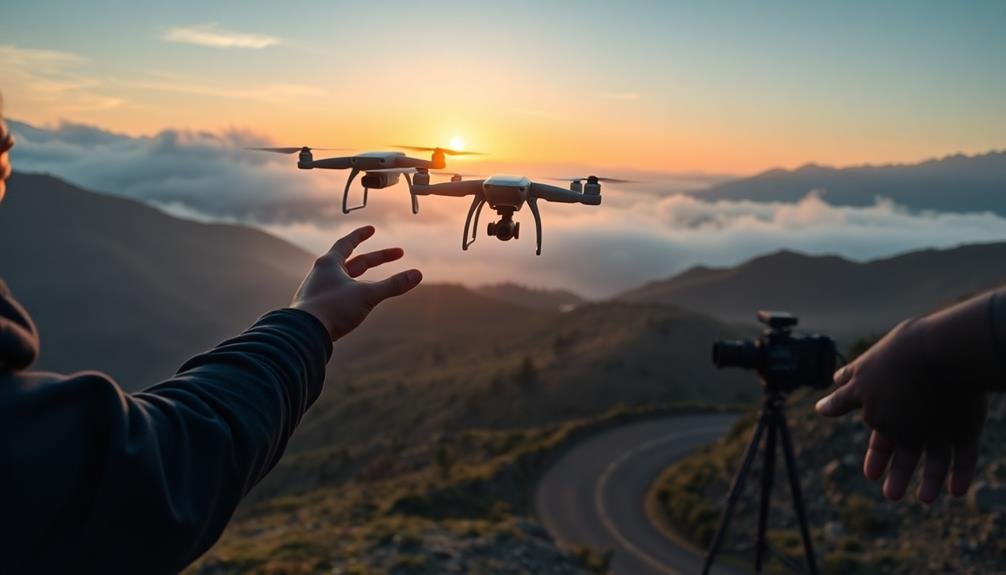
With your gear ready, it's time to focus on planning your shot composition. Start by scouting your location and identifying key visual elements you want to capture. Consider the direction of movement, foreground objects, and background scenery that'll enhance your aerial pan.
Think about the story you're telling with your shot. Are you revealing a landscape, following a subject, or creating a sense of scale? Your composition should support this narrative. Experiment with different altitudes and angles to find the most compelling perspective.
Pay attention to the rule of thirds and leading lines to create visually appealing frames. Use natural elements like roads, rivers, or coastlines to guide the viewer's eye through the shot. Don't forget to leave breathing room for your subject and consider the pace of your pan.
Plan your start and end points carefully. A strong opening and closing frame can make or break your aerial pan. Consider the lighting conditions and time of day to capture the best colors and shadows.
Mastering Smooth Drone Movement
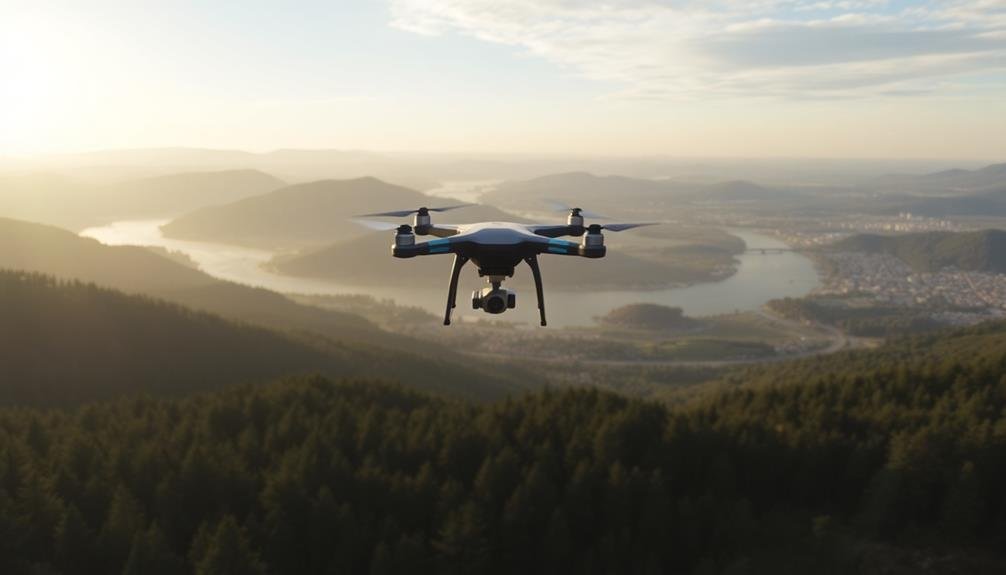
Smooth drone movement is the cornerstone of an enchanting aerial pan. To achieve this, you'll need to master your drone's controls and understand its flight characteristics.
Start by practicing basic maneuvers in an open area, focusing on gentle, consistent stick movements.
When executing your pan, use the drone's yaw function to rotate slowly while maintaining a steady altitude and forward speed. Aim for a fluid, cinematic motion by gradually accelerating and decelerating.
You can enhance smoothness by adjusting your drone's settings, such as reducing control sensitivity and enabling intelligent flight modes like "tripod" or "cinematic" mode.
Wind conditions play a vital role in drone movement. Always check the forecast and fly in calm weather when possible. If you must shoot in light winds, use them to your advantage by panning with the wind direction for added stability.
Post-production techniques can further refine your footage. Utilize warp stabilization in your editing software to iron out minor jitters, but remember that capturing smooth footage in-camera is always preferable.
With practice and patience, you'll soon be creating breathtaking aerial pans that captivate your audience.
Perfecting Speed and Timing
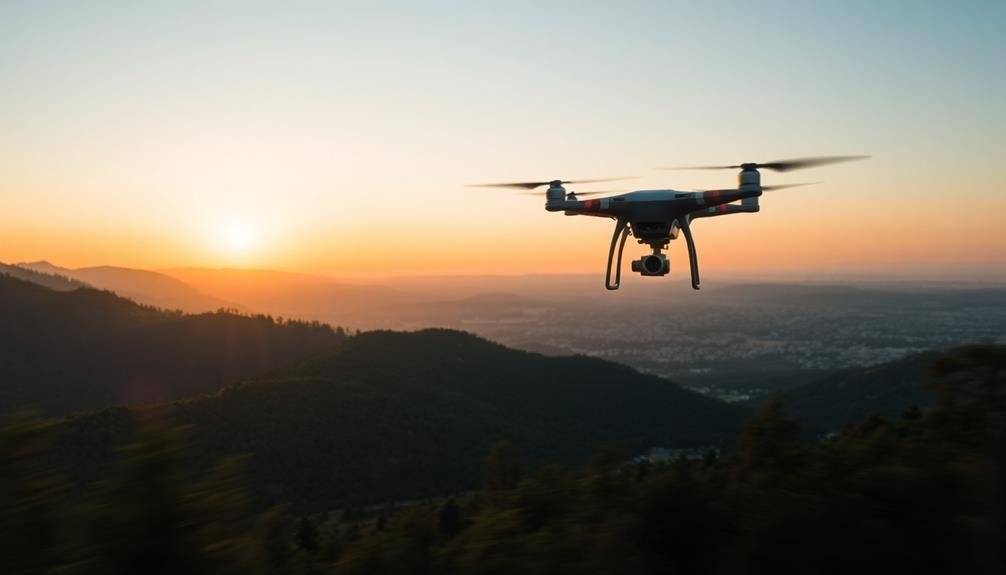
How fast should your drone move during an epic aerial pan? The ideal speed depends on your subject and the desired effect. For expansive landscape shots, slower speeds of 1-3 mph create a majestic, sweeping feel. For more dynamic scenes or to convey a sense of urgency, speeds of 5-10 mph can work well. Always consider your camera's frame rate and shutter speed to avoid motion blur.
Timing is equally essential. Start your pan before reaching the main subject to build anticipation. As you approach the focal point, gradually slow down to emphasize its importance. This deceleration also allows viewers to absorb more details. End your pan with a natural exit point, like a horizon or a complementary landscape feature.
Practice varying your speed within a single shot. Begin slowly, accelerate through the middle, and decelerate at the end. This technique adds drama and keeps viewers engaged.
Remember to account for wind conditions, as they can affect your drone's speed and stability. Always prioritize smooth, controlled movements over rapid changes that might appear jerky or unprofessional.
Advanced Panning Techniques
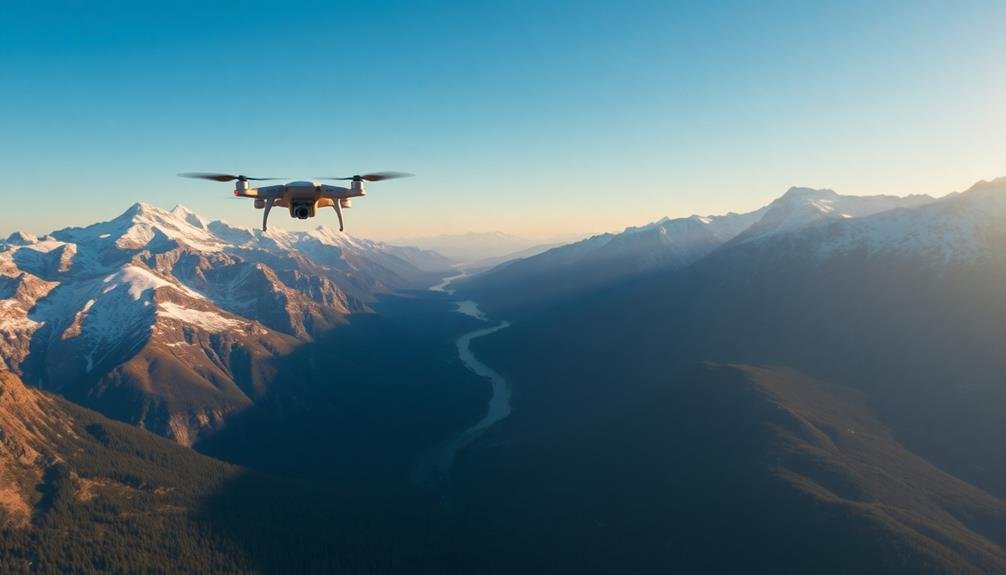
To elevate your aerial pans, you'll need to master smooth motion control and precise speed adjustments.
Focus on maintaining a steady hand and utilizing your drone's gimbal to its fullest potential.
Practice varying your pan speeds mid-shot to create dynamic and engaging footage that captures viewers' attention.
Smooth Motion Control
Achieving smooth motion control is the hallmark of professional aerial panning. You'll need to master precise throttle and stick movements to create fluid, cinematic shots. Start by practicing gentle, consistent inputs on your drone's controls. Aim for gradual acceleration and deceleration, avoiding abrupt starts and stops that can ruin your footage.
Utilize your drone's intelligent flight modes, such as Point of Interest or Waypoints, to automate complex movements. These features can help you maintain a steady pace and trajectory throughout your pan.
Don't forget to adjust your gimbal settings for peak smoothness. Slower pan and tilt speeds often yield more cinematic results.
Wind compensation is vital for smooth aerial pans. Learn to read wind patterns and adjust your flight path accordingly. You may need to fly slightly into the wind to maintain a straight line during your pan.
Experiment with different altitudes, as wind conditions can vary at different heights.
Precise Speed Adjustments
Nearly every professional-grade aerial pan relies on precise speed adjustments to create intriguing footage. To master this technique, you'll need to develop a keen sense of timing and control over your drone's movements.
Start by practicing gradual acceleration and deceleration. Begin your pan slowly, gradually increase speed, then smoothly slow down as you approach the end of your shot. This creates a dynamic feel that draws viewers into the scene. Experiment with different speed curves to find what works best for your subject and desired mood.
Use your drone's intelligent flight modes to achieve consistent speeds. Many drones offer features like "Point of Interest" or "Orbit" modes, which maintain a steady circular path around a subject. These can be invaluable for creating perfectly paced pans.
Don't forget to take into account your subject's movement speed. If you're panning to follow a moving object, match your drone's speed to create a sense of harmony. For stationary subjects, vary your speed to add visual interest.
Lastly, remember that slower pans often create a more cinematic feel, while faster ones can convey energy or urgency. Choose your speed wisely to support your story's narrative.
Post-Production Enhancements for Pans
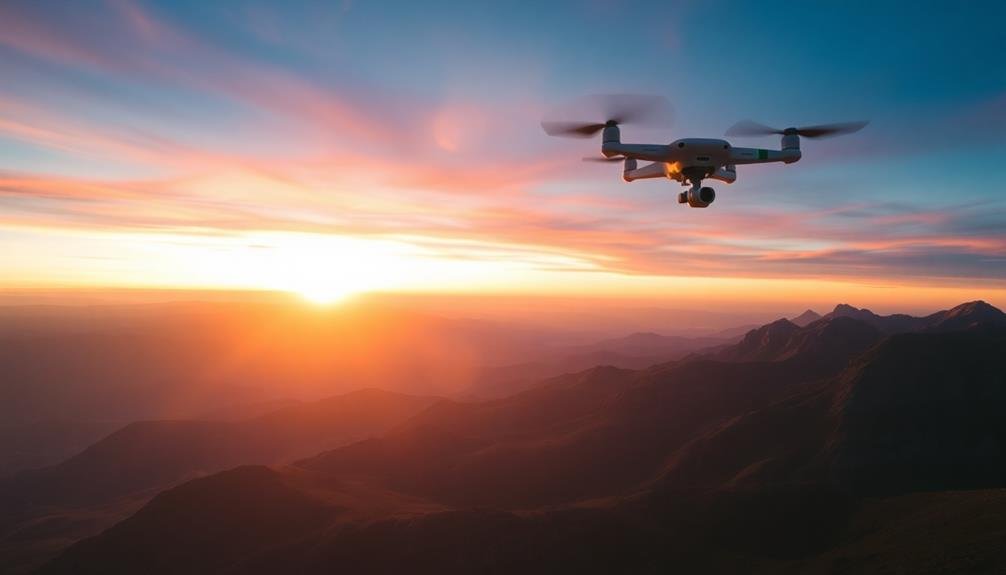
The final step in creating stunning aerial pans lies in post-production enhancements. You'll need to fine-tune your footage to achieve that professional look. Start by stabilizing your shots using software like Adobe Premiere Pro or DaVinci Resolve. This will smooth out any minor shakes or wobbles.
Color grading is essential for aerial pans. Adjust contrast, saturation, and white balance to create a cohesive look across your entire sequence. Don't forget to sharpen your footage slightly to enhance details.
For seamless shifts between shots, consider using subtle push or pull effects. You can also add a gentle zoom during the pan to create a more dynamic feel.
Here's a quick reference for common post-production enhancements:
| Enhancement | Purpose | Software |
|---|---|---|
| Stabilization | Reduce shake | Warp Stabilizer |
| Color Grading | Consistent look | Lumetri Color |
| Sharpening | Enhance details | Unsharp Mask |
| Speed Ramping | Dynamic pacing | Time Remapping |
| Motion Blur | Smooth movement | CC Force Motion Blur |
Lastly, don't overdo your enhancements. Subtle adjustments often yield the best results, maintaining the natural beauty of your aerial footage while elevating it to a professional standard.
Overcoming Common Aerial Panning Challenges
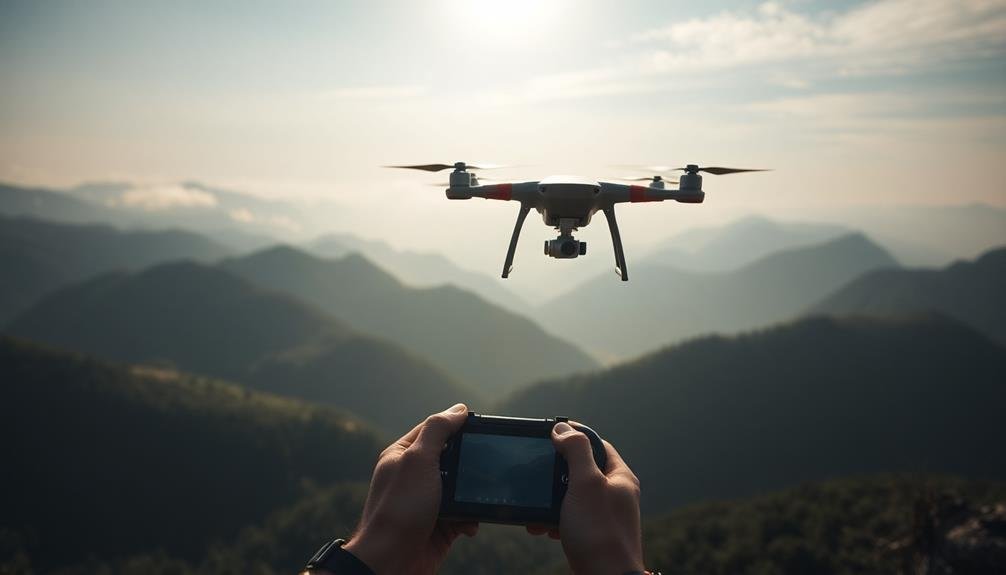
While post-production can enhance your aerial pans, it's best to address challenges during filming. You'll encounter various obstacles when executing aerial pans, but with practice and preparation, you can overcome them.
Wind is often your biggest enemy, causing camera shake and unpredictable drone movement. Combat this by using a higher-quality drone with advanced stabilization features and choosing calmer days for filming.
Another common issue is maintaining a consistent speed throughout the pan. Use your drone's intelligent flight modes or practice manual control to achieve smooth, steady movement.
Composition can be tricky when panning, so plan your shots carefully and use reference points to guide your framing.
Here are five more challenges you might face and how to overcome them:
- Battery life limitations: Bring spare batteries and plan shots efficiently
- Restricted airspace: Research and obtain necessary permits beforehand
- Focus issues: Use autofocus or pre-focus on key elements in the scene
- Exposure changes: Use manual settings or gradual exposure adjustments
- Signal interference: Invest in high-quality transmission systems and avoid obstacles
Frequently Asked Questions
How Do Weather Conditions Affect Aerial Panning Shots?
Weather conditions greatly impact your aerial panning shots. Wind can cause camera shake, while rain or fog may obscure visibility. Bright sunlight might create harsh shadows, and cloudy skies can affect lighting. You'll need to adapt your techniques accordingly.
What Insurance Considerations Are Important for Drone Cinematography?
You'll need liability insurance to cover potential damages or injuries. Don't forget equipment coverage for your drone and gear. Check local regulations, as some areas require specific insurance for commercial drone operations. Always prioritize safety and compliance.
Are There Specific Regulations for Aerial Panning in Urban Environments?
When aerial panning in urban areas, you'll need to follow specific regulations. You must obtain permits, respect no-fly zones, maintain visual line of sight, and adhere to altitude restrictions. Always check local laws before flying your drone.
How Can Aerial Panning Be Incorporated Into Narrative Storytelling?
You can use aerial panning to establish location, reveal plot points, or convey a character's emotions. It's great for shifts, building tension, or showing scale. Experiment with different angles and speeds to enhance your narrative's impact.
What Are the Best Practices for Collaborating With Clients on Aerial Pan Shots?
When collaborating with clients on aerial pan shots, you'll want to clearly communicate your vision, listen to their ideas, and show examples. Discuss safety concerns, obtain necessary permits, and guarantee you're aligned on the desired emotional impact.
In Summary
You've now got the tools to create stunning aerial pans. Remember, practice makes perfect. Don't be afraid to experiment with different techniques and push your creative boundaries. As you refine your skills, you'll develop your unique style. Keep challenging yourself, stay updated with the latest gear and software, and always prioritize safety. With dedication and these pro tips, you'll soon be capturing breathtaking aerial cinematography that'll wow your audience.

As educators and advocates for responsible drone use, we’re committed to sharing our knowledge and expertise with aspiring aerial photographers.
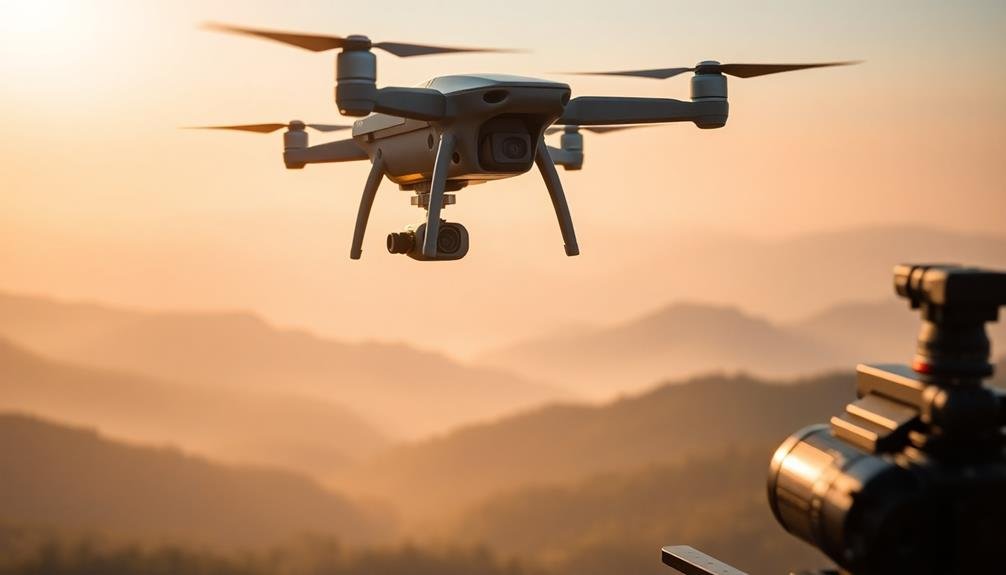



Leave a Reply